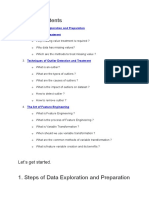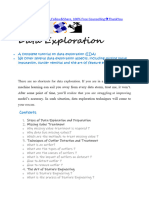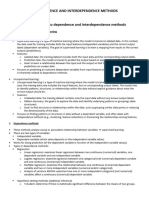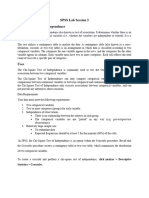Lesson 31
Uploaded by
misslaghari2Lesson 31
Uploaded by
misslaghari2Lesson 31
Two-Way ANOVA-I
Introduction to Two-Way ANOVA
Previously we discussed one way ANOVA which is an experimental design having only one
independent variable. In this chapter, we will extend the analysis of variance to cover experimental
designs involving two or more independent variables.
In real life, variable rarely exists or relate to other variables in isolation. To examine more complex
situations, researchers often design research studies that include more than one independent
variable. Researchers systematically change two (or more) variables and then observe how the
changes influence another (dependent) variable. When a research study involves more than one
factor, it is called a factorial design. And when a research study examines ANOVA having exactly
two factors, it is called Two-Way ANOVA. Tow-way ANOVA means groups are defined by two
independent variables. The two independent variables in a two-factor experiment are identified as
factor A and factor B. the goal of the factorial design is to evaluate the mean differences that may
be produced by either of the factors acting independently or by the two factors working together.
This technique allows us to look at the individual and joint effect of two independent variables on
one dependent variable
Main Effects and Interactions
The mean differences among the levels of one factor are referred to as the main effect of that factor.
When the design of the research study is represented as a matrix with one factor determining the
rows and the second factor determining the columns, then the mean differences among the rows
describe the main effect of one factor, and the mean differences among the columns describe the
main effect for the second factor.
For factorial ANOVA, we took an example of Shrauger’s study. Shrauger (1972) tested
participants on a concept-formation task. Half of the participants worked alone (no audience), and
©copyright Virtual University of Pakistan
half worked with an audience of people who claimed to be interested in observing the experiment.
Shrauger also divided the participants into two groups on the basis of personality: those high in
Self-esteem and those low in self-esteem. The dependent variable for this experiment was the
number of errors on the concept formation task. Data similar to those obtained by Shrauger are
shown in Figure below. Notice that the audience had no effect on the high-self-esteem participants.
However, the low-self-esteem participants made nearly twice as many errors with an audience
as when working alone. Note that the study involves two separate factors: One factor is
manipulated by the researcher, changing from no-audience to audience, and the second factor is
self-esteem, which varies from high to low. The two factors are used to create a matrix with the
different levels of self-esteem defining the rows and the different audience conditions defining the
columns. The resulting two-by-two matrix shows four different combinations of the variables,
producing four different conditions. Thus, the research study would require four separate samples,
one for each cell, or box, in the matrix. The dependent variable for the study is the number of errors
on the concept formation task for people observed in each of the four conditions.
The real advantage of combining two factors within the same study is the ability to examine not
only the main effects but the unique effects caused by an interaction. The concept of interaction
can be defined in terms of the pattern displayed in the graph.
©copyright Virtual University of Pakistan
To construct this figure, we select one of the factors to be displayed on the horizontal axis; in this
case, the different levels of the audience factor. The dependent variable, the number of errors, is
shown on the vertical axis. The figure actually contains two separate graphs: The top line shows
the relationship between the audience factor and errors for the low-self-esteem and the bottom
line shows the relationship for the high-self-esteem participants.
The A × B interaction typically is called the “A by B” interaction. If there is an interaction
between an audience and self-esteem, it may be called the “audience by self-esteem” interaction.
Hypotheses for Two-Way (ANOVA)
In ANOVA, the variable (independent or quasi-independent) that designates the groups being
compared is called a factor. The individual conditions or values that make up a factor are called
the levels of the factor. It consists of three hypothesis tests, two for main effects and one for
interaction.
Hₒ: No main effect of A
©copyright Virtual University of Pakistan
H₁: There exists a main effect of factor A
Hₒ: No main effect of B
H₁: There exists a main effect of factor B
Hₒ: No interaction
H₁: There exists an interaction between factor A and factor B
Degrees of Freedom (df)
For two-way ANOVA, we calculate three kinds of degrees of freedom.
1. Total Degrees of Freedom (dftotal)
2. Within-Treatments Degrees of Freedom (dfwithin)
3. Between-Treatments Degrees of Freedom (dfbetween)
Assumptions for the Independent- Measures ANOVA
The independent-measures ANOVA requires the same three assumptions that were necessary for
the independent-measures t hypothesis test:
1. The observations within each sample must be independent.
2. The populations from which the samples are selected must be normal.
3. The populations from which the samples are selected must have equal variances
(homogeneity of variance).
Two-Way ANOVA in SPSS
To run two-way ANOVA we need three variables:
• Two categorical independent variables (e.g. sex: males/females; age group: young,
middle, old)
• One continuous dependent variable (e.g. optimism).
©copyright Virtual University of Pakistan
Factor B
Treatments
I II
3 2
8 8
9 7
Male 4 7
0 12
0 6
Factor A
2 9
Gender
Female 6 13
The following data are from a two-factor study examining the depression scores across gender
and two treatment conditions. Use an ANOVA with α=.05 for all tests to evaluate the
significance of the main effects and the interaction.
We need to create two grouping variables in the variable view of SPSS as, treatment and
gender (i.e., the independent variables).
Depression scores are entered under the variable name depression (i.e., the dependent variable).
©copyright Virtual University of Pakistan
In the box of the ‘values’ we get a pop-up dialog that allows us to code the categorical variable.
Gender and Treatment conditions are coded as shown in the value labels window.
While entering data A code is entered for the categories of independent variables as (Gender:
1=male, 2=female; Treatment: 1=treatment1, 2=treatment2) and the depression scores in the
depression column.
©copyright Virtual University of Pakistan
To run one-way ANOVA in SPSS, from the menu at the top of the screen, click on Analyze
>General Linear Model >Univariate.
• A Univariate window opens.
• Click on the dependent, continuous variable (e.g. depression) and move it into the box
labelled Dependent Variable.
©copyright Virtual University of Pakistan
• Click on two independent, categorical variables (gender, treatment) and move these into
the box labelled Fixed Factors.
•
• Click on the Options button.\Click on Descriptive Statistics, Estimates of effect size
and Homogeneity tests and then Continue when finished.
• Click on the Post Hoc button.
• From the Factors listed on the left-hand side, choose the independent variable(s) you are
interested in (only if the variables have more than two levels).
• Click on the arrow button to move it into the Post Hoc Tests for section.
©copyright Virtual University of Pakistan
• Choose the test Tukey and click on Continue.
• Click on the Plots button.
• In the Horizontal Axis box, put the independent variable that has the most groups (e.g.
gender).
• In the box labelled Separate Lines, put the other independent variable (e.g. treatment).
• Click on Add.
• In the section labelled Plots, you will see the two variables listed as gender*treatment
• Click on Continue and then OK.
©copyright Virtual University of Pakistan
Assumptions of Two-Way ANOVA
The general assumptions include;
1. Random sampling
2. Independence of observations
3. Normal distribution (by assessing skewness, kurtosis, histogram, Q-Q plots, Shapiro-
Wilk and Kolmogorov-Smirnov tests).
Homogeneity of Variance
• Levene’s test for homogeneity of variances allows us to use the sample variances from
data to determine whether there is evidence for any differences among the population
variances.
• The Levene’s test for homogeneity of variances tests whether the variance in scores is
the same for each of the groups.
• For the assumption to be fulfilled the Sig. value should be greater than .05 and therefore
non-significant results. A significant result (Sig. value less than .05) suggests that the
variance of dependent variable across the groups is not equal.
• The Descriptive Statistics table provides the Mean scores, Std. deviations and N for
each subgroup.
©copyright Virtual University of Pakistan
• The main output from two-way ANOVA is a table labelled Tests of Between-Subjects
Effects.
• This table gives us the main effects and interaction effects.
• The first thing to do is to check for the possibility of an interaction effect (e.g., that the
influence of treatments on depression scores depends on whether the individual is male or
female).
• If the interaction effect is significant, the main effects cannot be interpreted easily.
• This is because, in order to describe the influence of one of the independent variables,
there is need to specify the level of the other independent variable.
• The output we need to look at is labelled gender*treatment.
©copyright Virtual University of Pakistan
• In this example, the interaction effect is significant (F= 7.529, p= .018).
• This indicates that there is significant difference in the effect of treatment on depression
males and females.
©copyright Virtual University of Pakistan
• To determine whether there is a main effect for each independent variable, in the left-hand
column, find the variable (e.g., gender) and check in the column marked Sig. next to each
variable. If the value is less than or equal to .05 there is a significant main effect for that
independent variable.
• In the output shown in the table, there is no significant main effect for gender (p= 1.00)
but a significant main effect for treatment (p= .018).
• This means that males and females do not differ in terms of their depression scores, but
there is a difference in scores for treatment I and treatment II.
©copyright Virtual University of Pakistan
• The effect size for the independent variables is provided in the column labelled Partial
Eta Squared (e.g., treatment, p= .386).
• ANOVA output also provides Post-hoc tests if the post hoc option is checked in the
analysis procedure since these are relevant only if we have more than two levels (groups)
of an independent variable.
• However, there is no need to look at them until you find a significant main effect or
interaction effect in the overall (omnibus) analysis of variance test.
©copyright Virtual University of Pakistan
You might also like
- Multivariate Analysis – The Simplest Guide in the Universe: Bite-Size Stats, #6From EverandMultivariate Analysis – The Simplest Guide in the Universe: Bite-Size Stats, #6No ratings yet
- Haleema Batool Major Asignment With ReferenceNo ratings yetHaleema Batool Major Asignment With Reference12 pages
- A Comprehensive Guide To Data Exploration: Steps of Data Exploration and Preparation Missing Value Treatment100% (2)A Comprehensive Guide To Data Exploration: Steps of Data Exploration and Preparation Missing Value Treatment8 pages
- AD3491 - Unit 4 - Analysis of Variance Important Questions 2 Marks With Answer --3-9 (1)No ratings yetAD3491 - Unit 4 - Analysis of Variance Important Questions 2 Marks With Answer --3-9 (1)7 pages
- Free Access to Solution Manual for Statistics for The Behavioral Sciences, 10th Edition Chapter Answers100% (4)Free Access to Solution Manual for Statistics for The Behavioral Sciences, 10th Edition Chapter Answers48 pages
- Assignment-Practical Exercise in One-Way AnovaNo ratings yetAssignment-Practical Exercise in One-Way Anova11 pages
- Different Statistical Tests With Uses and ExamplesNo ratings yetDifferent Statistical Tests With Uses and Examples7 pages
- An Introduction To Two-Way ANOVA: Prepared ByNo ratings yetAn Introduction To Two-Way ANOVA: Prepared By46 pages
- Analysis of Co-Variance (ANCOVA) and Multivariate Analysis of Co-Variance (Mancova)100% (1)Analysis of Co-Variance (ANCOVA) and Multivariate Analysis of Co-Variance (Mancova)37 pages
- Quality Leadership University Prof. Hilmar Castro June 2018No ratings yetQuality Leadership University Prof. Hilmar Castro June 201816 pages
- Statistical Inferance Anova, Monova, Moncova Submitted By: Ans Muhammad Submitted To: Sir Adnan Ali CHNo ratings yetStatistical Inferance Anova, Monova, Moncova Submitted By: Ans Muhammad Submitted To: Sir Adnan Ali CH9 pages
- Guide For The Interpretation of Two-Way Analysis oNo ratings yetGuide For The Interpretation of Two-Way Analysis o7 pages
- Overview Of Bayesian Approach To Statistical Methods: SoftwareFrom EverandOverview Of Bayesian Approach To Statistical Methods: SoftwareNo ratings yet
- MSF 566 Topic 04 Modeling With VolatilityNo ratings yetMSF 566 Topic 04 Modeling With Volatility74 pages
- Econometrics - Exercise set 1 (solution)No ratings yetEconometrics - Exercise set 1 (solution)7 pages
- Nama: Syafitri Putri Gusasi (2100032) Kelas: A - Akuntansi Mata Kuliah: Statistika Dan Analisis Data 1. ANo ratings yetNama: Syafitri Putri Gusasi (2100032) Kelas: A - Akuntansi Mata Kuliah: Statistika Dan Analisis Data 1. A9 pages
- Cheat Sheet Quantitative Methods in Finance Nova Cheat Sheet Quantitative Methods in Finance Nova0% (1)Cheat Sheet Quantitative Methods in Finance Nova Cheat Sheet Quantitative Methods in Finance Nova3 pages
- An Introduction To Supervised Machine Learning and Pattern Classification - The Big PictureNo ratings yetAn Introduction To Supervised Machine Learning and Pattern Classification - The Big Picture55 pages
- Performance Evaluation of Indian Khadi and Village Industries - 1No ratings yetPerformance Evaluation of Indian Khadi and Village Industries - 116 pages
- Chapter Two: Simple Linear Regression Models: Assumptions and Estimation100% (3)Chapter Two: Simple Linear Regression Models: Assumptions and Estimation34 pages
- Performance Metrics (Classification) : Enrique J. de La Hoz D100% (1)Performance Metrics (Classification) : Enrique J. de La Hoz D30 pages
- New Multivariate Time-Series Estimators in Stata 11100% (1)New Multivariate Time-Series Estimators in Stata 1134 pages
- Introduction To Generalized Linear Models: Logit Model With Categorical Predictors. BeforeNo ratings yetIntroduction To Generalized Linear Models: Logit Model With Categorical Predictors. Before24 pages
- A review of the-state-of-the-art in data-driven approaches for buildingNo ratings yetA review of the-state-of-the-art in data-driven approaches for building23 pages
- Measures of Fit For Logistic Regression: Paul D. Allison, Statistical Horizons LLC and The University of PennsylvaniaNo ratings yetMeasures of Fit For Logistic Regression: Paul D. Allison, Statistical Horizons LLC and The University of Pennsylvania12 pages
- Full download Applied Multivariate Statistics for the Social Sciences Fifth Edition James P. Stevens pdf docxNo ratings yetFull download Applied Multivariate Statistics for the Social Sciences Fifth Edition James P. Stevens pdf docx51 pages
- Multivariate Analysis – The Simplest Guide in the Universe: Bite-Size Stats, #6From EverandMultivariate Analysis – The Simplest Guide in the Universe: Bite-Size Stats, #6
- A Comprehensive Guide To Data Exploration: Steps of Data Exploration and Preparation Missing Value TreatmentA Comprehensive Guide To Data Exploration: Steps of Data Exploration and Preparation Missing Value Treatment
- AD3491 - Unit 4 - Analysis of Variance Important Questions 2 Marks With Answer --3-9 (1)AD3491 - Unit 4 - Analysis of Variance Important Questions 2 Marks With Answer --3-9 (1)
- Free Access to Solution Manual for Statistics for The Behavioral Sciences, 10th Edition Chapter AnswersFree Access to Solution Manual for Statistics for The Behavioral Sciences, 10th Edition Chapter Answers
- Different Statistical Tests With Uses and ExamplesDifferent Statistical Tests With Uses and Examples
- Analysis of Co-Variance (ANCOVA) and Multivariate Analysis of Co-Variance (Mancova)Analysis of Co-Variance (ANCOVA) and Multivariate Analysis of Co-Variance (Mancova)
- Quality Leadership University Prof. Hilmar Castro June 2018Quality Leadership University Prof. Hilmar Castro June 2018
- Statistical Inferance Anova, Monova, Moncova Submitted By: Ans Muhammad Submitted To: Sir Adnan Ali CHStatistical Inferance Anova, Monova, Moncova Submitted By: Ans Muhammad Submitted To: Sir Adnan Ali CH
- Guide For The Interpretation of Two-Way Analysis oGuide For The Interpretation of Two-Way Analysis o
- Overview Of Bayesian Approach To Statistical Methods: SoftwareFrom EverandOverview Of Bayesian Approach To Statistical Methods: Software
- Nama: Syafitri Putri Gusasi (2100032) Kelas: A - Akuntansi Mata Kuliah: Statistika Dan Analisis Data 1. ANama: Syafitri Putri Gusasi (2100032) Kelas: A - Akuntansi Mata Kuliah: Statistika Dan Analisis Data 1. A
- Cheat Sheet Quantitative Methods in Finance Nova Cheat Sheet Quantitative Methods in Finance NovaCheat Sheet Quantitative Methods in Finance Nova Cheat Sheet Quantitative Methods in Finance Nova
- An Introduction To Supervised Machine Learning and Pattern Classification - The Big PictureAn Introduction To Supervised Machine Learning and Pattern Classification - The Big Picture
- Performance Evaluation of Indian Khadi and Village Industries - 1Performance Evaluation of Indian Khadi and Village Industries - 1
- Chapter Two: Simple Linear Regression Models: Assumptions and EstimationChapter Two: Simple Linear Regression Models: Assumptions and Estimation
- Performance Metrics (Classification) : Enrique J. de La Hoz DPerformance Metrics (Classification) : Enrique J. de La Hoz D
- New Multivariate Time-Series Estimators in Stata 11New Multivariate Time-Series Estimators in Stata 11
- Introduction To Generalized Linear Models: Logit Model With Categorical Predictors. BeforeIntroduction To Generalized Linear Models: Logit Model With Categorical Predictors. Before
- A review of the-state-of-the-art in data-driven approaches for buildingA review of the-state-of-the-art in data-driven approaches for building
- Measures of Fit For Logistic Regression: Paul D. Allison, Statistical Horizons LLC and The University of PennsylvaniaMeasures of Fit For Logistic Regression: Paul D. Allison, Statistical Horizons LLC and The University of Pennsylvania
- Full download Applied Multivariate Statistics for the Social Sciences Fifth Edition James P. Stevens pdf docxFull download Applied Multivariate Statistics for the Social Sciences Fifth Edition James P. Stevens pdf docx

























































































